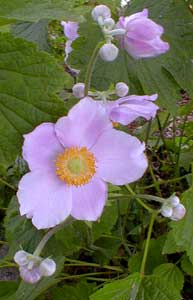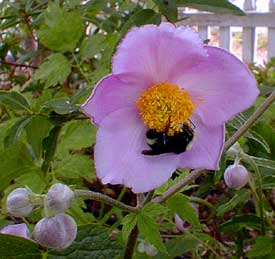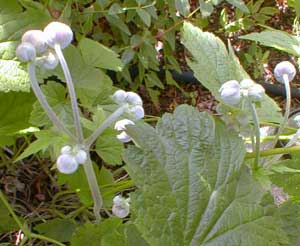
'Kriemhilde'
Japanese Anemone
or Windflower
"As in a sky all starlit
the moon shines out so bright,
And through the cloudlets peering
pours down her gentle light,
E'en so was Kriemhild's beauty
among her ladies fair:
The hearts of gallant heroes
were gladder when they saw her there."
from a 1904 translation of
Die Nibelungenleid
Die Nibelungenleid
Anemone hybrida is the nursery trade's name for a broad series of wonderful hybrid anemones that begin with Japanese Anemone (A. hupehensis var japonica).
 Sometimes A. hupehensis is said to be the new name, formerly called A. japonica, but this is incorrect. A. h. var japonica is a natural variant with a mix of single & semi-double petals. From it many hybrids acquired larger fuller blooms.
Sometimes A. hupehensis is said to be the new name, formerly called A. japonica, but this is incorrect. A. h. var japonica is a natural variant with a mix of single & semi-double petals. From it many hybrids acquired larger fuller blooms.It's also later blooming than regular A. hupehensis, & can get taller — five feet occasionally, four feet quite often. In the nursery trade, A. h. var japonica cultivars are lumped together with A. hupehensis cultivars & all categorized as A. x. hybrida.
Some anemones are invasive (A. tomentosa & A. canadensis for examples) but Japanese anemones are well-behaved. Though called Japanese Anemone, it is actually native of China, though it has long been naturalized in Japan.
Robert Fortune first introduced the species into English gardening in 1844. He reported that in Shanghei, it was commonly planted on graves, so seems to have had associations with death, perhaps because it becomes liveliest when most of the plant-world is becoming quiescent in preparation for winter.
 'Kriemhilde' is an old hybrid, known to gardening since 1909. It is named after one of a women warrior encountered in the heroic fantasy epic, The Nibelungenlied. Her name means "Helm of Battle," but being the feminine form, can be said to mean "Helmeted Woman Warrior."
'Kriemhilde' is an old hybrid, known to gardening since 1909. It is named after one of a women warrior encountered in the heroic fantasy epic, The Nibelungenlied. Her name means "Helm of Battle," but being the feminine form, can be said to mean "Helmeted Woman Warrior."Kriemhilde was samurai-like in the manner by which she patiently bided her time, in the manner of the heroic 47 Ronin, until the moment was prepared to avenged her slain husband, the dragonslayer Sigurd (Sigfried). Included on this page is a portrait of the Teutonic amazon as portrayed by Margarete Schon in a 1924 Fritz Lang silent film.
 As a generality, anemones with tuberous rhizomes bloom spring & summer, whereas those with fibrous roots, including all the "hybrida" types, bloom late summer & in autumn.
As a generality, anemones with tuberous rhizomes bloom spring & summer, whereas those with fibrous roots, including all the "hybrida" types, bloom late summer & in autumn.Ours blooms starting in August & continues until first frost, often as late as October. The August portraits on this page include a bud portrait from the very beginning of the month. In spring & early summer before blooming, it has a beautiful large-leafed presence.
'Kriemhilde' is three to four feet tall with pale pink-purple semi-double flowers, with a darker shade of pallid pink on the reverse, lending color to shady corners of the late summer & early autumn garden. Bees & butterflies love the hell out of these flowers.
A clump will survive in sun or full shade, but partial shade is ideal, in moist humousy soil.
Propagation is by division in early spring before new growth begins, probably not more often than every third year.
Because they do get quite big when well-established, make sure they really do have room to spread their leaves.